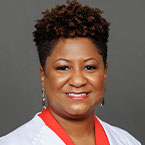By: Lisa Eiland, MD, FAAP & Candrice Heath, MD, FAAP, FAAD
Whether or not a person with textured hair chooses to straighten it is a matter of personal or family choice. If your child is interested in straightening their hair, it is important to consider the risks and benefits of each method before making the decision. Read on to learn more.
How to straighten hair: 3 basics techniques
There are three ways to straighten textured hair: by
stretching the hair, applying
heat, or using
chemical straighteners.
1. Stretching hair with ribbons, threads, braids & twists
Stretching is one method that's used to temporarily straighten textured hair. After washing and conditioning the hair, it is separated into small sections. More traditionally, these sections are wrapped from root to tip with ribbons or threads that are left in place until the hair dries. Alternatively, textured hair can be stretched by securing multiple ponytail holders or fabric covered bands down the length of each hair section.
Braiding or twisting (2-strand twists) washed hair is also used for a looser stretch. Once the hair is dry, banding materials, twists, and/or braids can be removed. Hair will remain in a stretched or straightened state until it gets wet. When stretching hair, caution should be used to prevent painful or sustained tension on the scalp or hair strands.
2. Heating hair with styling tools
Heat can also be used to temporarily straighten textured hair. Hair is made up of a protein called keratin; by applying heat, the bonds that keep the keratin in its natural state are temporarily broken. Blow dryers, flat irons and hot combs are examples of tools that can be used to straighten the hair with heat.
Before applying heat, hair should be washed and conditioned. A heat protectant product should be applied.
Blow dryers are commonly used in combination with a comb attachment or styling brush to straighten the hair. Blow dryers typically generate heat in the range of 80 to 140 degrees Fahrenheit. To prevent heat damage to the hair or scalp, it is important to start with lower temperatures and cautiously increase to achieve desired results.
Flat irons generally heat to the range of 250-500 degrees Fahrenheit, and some hot combs can reach temperatures over 800 degrees Fahrenheit.
The temperature of all heat styling tools should be set under 350 degrees Fahrenheit; even then, damage to the hair may occur. Because heat tools reach high temperatures, extreme caution is needed to prevent burns of the hair and/or skin. The ears and face are especially vulnerable to burns during heat straightening. For this reason, avoid using heat tools with children who are not able to comfortably sit for extended periods of time to have their hair styled.
3. Chemical hair straighteners
Chemical hair straighteners, also called relaxers, work by permanently breaking down the bonds in hair that give it its structure. After the hair grows, the hair (new growth) will again have the person's natural hair texture.
People with textured hair may choose to use chemical straighteners because of their long-lasting results; however, they have several
health risks.
Chemical hair straighteners are not designed to be applied directly to the scalp, but they may come in contact with the scalp during application. This can cause chemical burns that may increase in severity the longer the chemical straightener is left on. Chemical hair straighteners should be applied by licensed professionals.
Chemical straighteners can also be absorbed into the bloodstream from the scalp and have negative health effects. Many chemical hair straighteners contain endocrine disrupting chemicals (EDCs), which impact the body's hormone system, for example.
When absorbed into the bloodstream, EDCs can affect the timing of a person's first
menstrual period and increase their risk of postmenopausal uterine cancers. The health risks increase the more that chemical hair straighteners are used.
EDCs are present even in chemical straighteners that are marketed for use in children. For example, all five of the EDCs banned under California's
Proposition 65 are found in a chemical hair straightening product marketed for children. In fact, the U.S. Food & Drug Administration (FDA) plans to propose a ban on some chemical hair straighteners because they contain ingredients that increase the risk of certain
cancers.
Another risk associated with chemical hair straighteners is ingestion by young children. These products do not contain safety caps, so young children may be able to open the containers and eat the product. The chemicals in hair straighteners can cause severe damage to the digestive tract.
Parents should carefully consider the health risks associated with chemical hair straighteners before using them on children. Also, it is important to keep these products out of the reach of children.
Textured hair in its natural state
Some people choose not to straighten their hair and instead wear their hair in its textured state. When caring for hair in its textured state, gentle hair care practices are recommended to avoid breakage, dryness and knots.
What to know about the CROWN Act
People have the right to style their hair according to personal style and convenience, this includes those with textured hair. Some settings such as schools and workplaces may ban certain natural hair styles; however, this is a form of discrimination that is being opposed by the
CROWN (Creating A Respectful and Open World for Natural Hair) Act legislation.
Remember
When choosing hair styles and styling products, it's important to consider their effect on hair, scalp,
self-esteem and overall health. Families should make informed decisions on the techniques and products used to straighten textured hair.
More information
About Dr. Eiland
 Lisa Eiland, MD, FAAP, is a board-certified neonatologist and Division Chief of Neonatology at the Joseph M. Sanzari Children's Hospital at Hackensack University Medical Center. She currently serves as President of New York State Chapter 3 of the American Academy of Pediatrics and as it's District II Equity, Diversity and Inclusion Champion. Lisa Eiland, MD, FAAP, is a board-certified neonatologist and Division Chief of Neonatology at the Joseph M. Sanzari Children's Hospital at Hackensack University Medical Center. She currently serves as President of New York State Chapter 3 of the American Academy of Pediatrics and as it's District II Equity, Diversity and Inclusion Champion.
About Dr. Heath
 Candrice Heath, MD, FAAP, FAAD, is a triple board-certified dermatologist for both children and adults, an Adjunct Clinical Assistant Professor at Temple University, and will start practicing in Washington, DC in summer 2024. She also chairs the Skin of Color and Pigmentation Disorders Study Group in the Pediatric Dermatology Research Alliance. Candrice Heath, MD, FAAP, FAAD, is a triple board-certified dermatologist for both children and adults, an Adjunct Clinical Assistant Professor at Temple University, and will start practicing in Washington, DC in summer 2024. She also chairs the Skin of Color and Pigmentation Disorders Study Group in the Pediatric Dermatology Research Alliance.
|